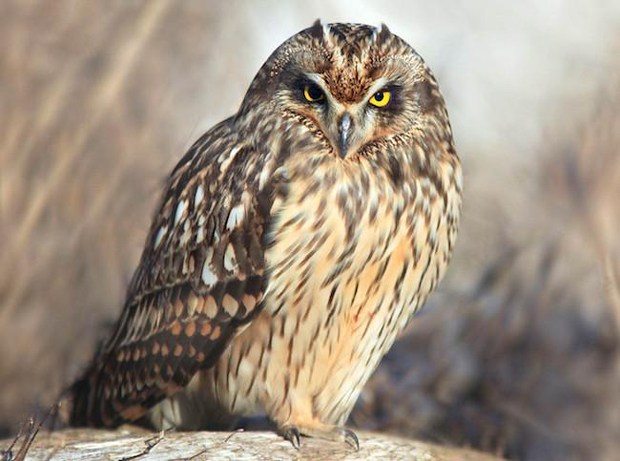Hawaiian short-eared owl
The Pueo, or Asio Flames Sandwichensis, is endemic to the Hawaiian Islands. What is the difference between endemic and indigenous, you ask? Okay maybe you didn’t ask but here goes anyways. Endemic means it is native (came here by natural means) and is specific to ONE location, either an entire island OR a small section of land (think of the silversword of Haleakalā). Pueo can be found on Kauaʻi, Maui, Oʻahu and Hawaiʻi. No where else. In the world. An adult pueo is brown and white, eyes are yellow and the bill is black. It has feathered feet and legs.
When you call a barn owl a pueo, it isn’t really one. Maybe call it a pueo malihini, a newcomer owl. Unlike the common barn owl (the owl we most often see here in Hawaiʻi at night), the pueo is diurnal. That is, it hunts during the day (most active at dawn and dusk). They can be seen most often hunting in grasslands, searching for rodents, insects, and sometimes, though rarely, birds. I love watching them flying right above the grass in Waimea and Waikiʻi. So beautiful. Because their nest is built on the ground they are highly susceptible to being disturbed by feral cats and mongoose, probably a major cause for the decline in population.
The pueo is worshipped, like the ʻio (Hawaiian hawk), as anʻaumakua by some ʻohana. They are considered protectors, especially in battle. In one well known legend, Kahalaopuna, a young woman, is killed by her husband, only to be revived by the family ʻaumakua, a pueo. In Kamakau’s writing in Kūʻokoʻa (June 1, 1867), he relates a true story of a woman, Kahulunuikaʻaumoku, killed in battle, who is saved by a pueo who guides her to safety and finds a kahu, or caretaker, to feed her and care for her injuries.
Thus is the power of the mighty pueo, mystic bird of the past, majestic bird of the present.

Malu ke kula, ʻaʻohe keʻu pueo – The plain is quiet, not even the hoot of a pueo is heard (all is at peace).
Copyright: 2018 – Liana Iaea Honda. All rights reserved. All versions of “He Momi e Lei ai”, in its entirety, past and present, is the property of L. K. I. Honda. Reproduction and use of any kind other than the sharing of this website is prohibited without written consent. Alteration to the original content in any form is prohibited in every and any instance, and use in any other variant is prohibited without written consent of the author. Address inquiries to: hemomi [at] gmail.com. Definitions and wise sayings are from: Hawaiian Dictionary by Pukui and Elbert, 1986. ʻŌlelo Noʻeau – Hawaiian Proverbs & Poetical Sayings by Mary Kawena Pukui, 1983.

Thanks for resuming posting, Liana, I really enjoy your he Momi!
Sent from my iPhone